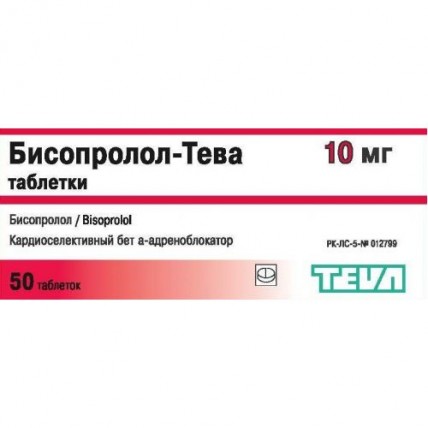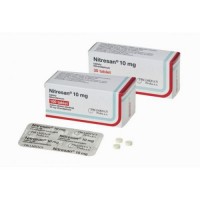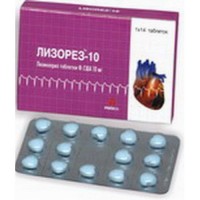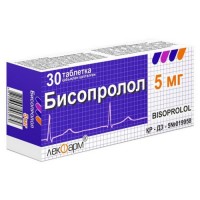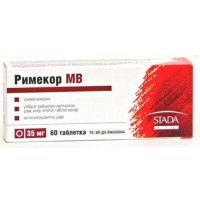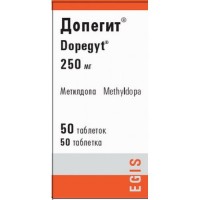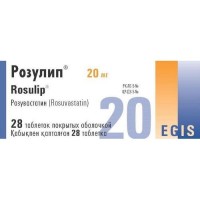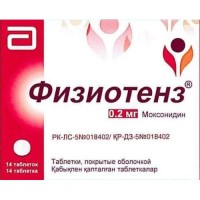Bisoprolol-Teva 10 mg (50 tablets)
- $15.90
Sku:
79873014d829
Ingredient:
Bisoprolol
The instruction for medical use of medicine of Bisoprolol-Tev the Trade name of Bisoprolol-Tev the International unlicensed name Bisoprolol Lekarstvennaya a form of the Tablet, 5 and 10 mg Structure One tablet contains active agent - a bisoprolol gemifumarat 5 mg or 10 mg, excipients: lactoses monohydrate, cellulose microcrystalline, krospovidon (Kollidon CL), dye yellow PB 22812 **, dye beige PB 27215 **, magnesium stearate * - the Existing edition ** Composition of dye of yellow PB 22812: Lactoses monohydrate - 87%, gland (II) oxide yellow E172 - 13% ** Composition of dye of beige PB 27215: Lactoses monohydrate – 60%, gland (II) oxide of yellow E 172 - 38%, iron (II) oxide red E172 – 2%. The description the Round biconvex tablets pale with yellow impregnations, with the forced-out figure 5 and risky on the one hand and smooth from a reverse side (for a dosage of 5 mg). The round biconvex tablets pale with beige impregnations, with the forced-out figure 10 and risky on the one hand and smooth from a reverse side (for a dosage of 10 mg). Pharmacotherapeutic group Beta blockers. Selection beta blockers. Bisoprolol. The ATX C07AB07 code the Pharmacological Bisoprolol Pharmacokinetics Absorption properties almost completely (& gt, 90%) is soaked up from digestive tract. Absorption does not depend on meal. Because of the low presistemny metabolism – less than 10% − have absolute bioavailability about 90%. Distribution Linking with proteins of blood plasma reaches about 30%. Distribution volume − 3.5 l/kg. Metabolism and removal Bisoprolol is brought out of an organism in two equally effective ways: 50% are metabolized in a liver to inactive metabolites which then are removed by kidneys, and other 50% are removed by kidneys in a nemetabolizirovanny form. As removal happens in kidneys and a liver equally, correction of a dose usually is not required from patients from the liver broken by function or kidneys easy and moderate severity. The general clearance of a bisoprolol is 15 l/h. Elimination half-life of a bisoprolol is equal to 10-12 hours. The pharmacodynamics Bsiprolol - high-selection β1-адреноблокатор, has no internal sympathomimetic and membrane stabilizing activity. Has low affinity to β2-рецепторам smooth muscles of bronchial tubes and vessels and to β2-рецепторам enzymatic metabolic regulation. Thus, bisoprolol, as a rule, does not influence resistance of airways and the beta2-mediated metabolic processes. Its beta1-selectivity exceeds the limit of range therapeutic dosed It is known that the bisoprolol has no negative inotropic effect. The maximum effect of a bisoprolol is reached in 3-4 hours after oral administration. Elimination half-life (10-12 hours) provides 24-hour efficiency at administration of drug once a day. Generally, the maximum antihypertensive effect of a bisoprolol is reached after 2 weeks treatment. At therapy of acute conditions of patients with coronary heart disease without chronic heart failure, bisoprolol reduces heart rate and reduces stroke output that leads to decrease in fraction of emission and consumption of oxygen. At therapy of chronicities originally increased peripheric resistance decreases. Decrease of the activity of renin of plasma is the cornerstone of antihypertensive effect of beta-blockers. Bisoprolol suppresses the answer to simpatoadrenergichesky activity by blocking of cardiac beta1-receptors. This effect causes delay of heartbeat and decrease in contractility that leads to decrease in consumption by an oxygen myocardium. The last causes desirable effect in patients with stenocardia and coronary heart disease. Indications - arterial hypertension - coronary heart disease (stenocardia) the Route of administration and doses of the Tablet should be accepted with a small amount of liquid, without chewing in the morning till a breakfast, in time or after it. A dosage Treatment has to be begun generally gradually, with small doses which then increase. In all cases the dose has to be selected individually, considering pulse rate and therapeutic effect. Treatment of arterial hypertension the Recommended Bisoprolol-Tev's dose makes 5 mg once a day. At easy forms of a hypertension (diastolic arterial blood pressure up to 105 mm Hg.), therapy by a dose of 2.5 mg can be sufficient once a day. If necessary it is possible to increase a dosage to 10 mg once a day. Further increase in a dose has to be proved and be carried out in exceptional cases. The Maksialny recommended Bisoprolol-Tev's dose makes 20 mg once a day. Coronary heart disease (stenocardia) the Recommended Bisoprolol-Tev's dose makes 5 mg once a day. If necessary it is possible to increase a dosage to 10 mg once a day. Further increase in a dose has to be proved and be carried out in exceptional cases. The maximum recommended Bisoprolol-Tev's dose makes 20 mg once a day. The dosage in a liver and/or renal failure or kidneys of easy or moderately severe correction of the mode of dosing, as a rule, is not required to Patients with abnormal liver functions. For patients with heavy renal failures (clearance of creatinine & lt, 20 ml/min.) and patients with heavy abnormal liver functions the maximum daily dose makes 10 mg. There is only a limited experience of use of Bisoprolol-Tev at dialysis patients which does not indicate the need to correction of the mode of dosing. Elderly people Correction of a dosage is not required. Treatment duration Duration of treatment is not limited and depends on the disease course and severity. It is impossible to stop sharply Bisoprolol-Tev's treatment, especially at patients with coronary heart disease as it can lead to acute aggravation of symptoms of health of the patient. If suspension of treatment is necessary, the dose has to decrease gradually (for example, twice reducing a dose once a week). Side effects Often ( 1/100, 1/10) - dizziness *, a headache * - nausea, vomiting, diarrhea, a constipation, an abdominal pain - cryesthesia or numbness in extremities, strengthening of the available alternating lameness - fatigue *, weakness Infrequently ( 1/1000, 1/100) - bradycardia, disturbances of atrioventricular conductivity, deterioration in the available heart failure - a bronchospasm with bronchial asthma or with an obstructive disease of respiratory organs in the anamnesis - muscle weakness, muscular spasms, spasms, an arthropathy - orthostatic hypotonia - an asthenia - a depression, sleep disorders Seldom ( 1/10,000, 1/1000) - nightmares, hallucinations - a hearing disorder - a syncope - reduction of dacryagogue (it is necessary to consider when carrying contact lenses by the patient) - reactions of hypersensitivity (itching, inflow, a dieback), reddening, rash - allergic rhinitis, emergence of antinuclear antibodies with unusual clinical symptoms, such as lupus syndrome which disappear with completion of treatment - hepatitis - disturbances of potency - increase in level of liver enzymes (AlAT, AsAT), triglycerides, a hypoglycemia Very seldom ( 1/10,000) - psoriasis or to cause a dieback, similar to psoriasis, a hair loss in patients. - conjunctivitis - conjunctivitis * These symptoms arise more often in an initiation of treatment. They, as a rule, have low-intensive character and usually disappear within 1-2 weeks. Contraindications - hypersensitivity to a bisoprolol or to any of drug components - an acute heart failure or heart failure in a stage of a decompensation which demands intravenous inotropic therapy - cardiogenic shock - atrioventricular block of II and III degree (without electrocardiostimulator) - a sick sinus syndrome (Sick-Sinus-Syndrom) - sinuatrial blockade - symptomatic bradycardia with less than 60th blows/minute before an initiation of treatment - symptomatic hypotension (systolic blood pressure is lower than 100 mm Hg.) - severe forms of bronchial asthma and chronic obstructive pulmonary disease in the anamnesis - late stages of a peripheral arterial occlusive disease or a Raynaud's disease - not treated pheochromocytoma - a metabolic acidosis - combinations with floktafeniny and sultopridy - a concomitant use of inhibitors of a monoaminooxidase (except MAO inhibitors type B) - intolerance of a galactose, deficiency of Lappa lactase, malabsorption of a galactose glucose - children's age up to 18 years (the efficiency and safety are not established) - pregnancy and the period of a lactation With care - a hypertension or stenocardia with the accompanying heart failure - diabetes with considerable fluctuations of level of glucose in blood, hypoglycemia symptoms (for example, tachycardia, a cardiopalmus or perspiration), which can be disguised - a rigid diet - the continuing desensibilizing therapy - the first extent of AV-blockade - Pritsmetal's stenocardia - a peripheral arterial occlusive disease (complaints, especially at the beginning of therapy can increase) - to patients who in the anamnesis have a psoriasis beta-blockers (for example, bisoprolol) have to be appointed only after careful assessment of advantage/risk. Medicinal interactions the Concomitant use of other drugs can affect effect and tolerance of drug. Similar interactions can also happen if from the moment of acceptance of other drug there passed not enough time. Inform your attending physician if you take any other drugs. Simultaneous use with the following drugs is not recommended: Antagonists of calcium of type of verapamil and to a lesser extent, diltiazem, at simultaneous use with Bisoprolol-Tev's drug can lead to decrease in sokratitelny ability of a cardiac muscle and delay carrying out atrioventricular impulses. In particular, intravenous administration of verapamil to the patients receiving therapy by beta-blockers can lead to deep hypotension and atrioventricular block. Hypotensive drugs of the central action (such as clonidine, Methyldopum, moksonidin, rilmenidin) can lead to reduction of ChSS and warm emission and also to a vazodilatation owing to decrease in the central sympathetic tone. Sharp cancellation, especially before cancellation of beta-blockers can increase risk of developing ricochet hypertensia. With care to apply with the following drugs: Antiarrhytmic means of class I (for example, quinidine, Disopyramidum, lidocaine, Phenytoinum, flekainid, propafenon): influence time of atrioventricular conductivity and also the negative inotropic effect can increase. Blockers of calcium channels as dihydropyridine (for example, nifedipine): combined use can increase risk of hypotension and also disturbance of delivery function of ventricles at patients with heart failure is not excluded. Antiarrhytmic means of class III (for example, Amiodaronum): strengthening of influence on time of atrioventricular conductivity is possible. Parasympathomimetics: combination therapy can increase time of atrioventricular conductivity and increase risk of bradycardia. Topical administration of beta-blockers (for example, eye drops for treatment of glaucoma) can enhance system effect of a bisoprolol. Antihyperglycemic effect of insulin and oral antidiabetic means can amplify. Blockade of beta adrenoceptors can hide hypoglycemia symptoms. The anesthetizing drugs: easing of reflex tachycardia and increase in risk of hypotension. Cardiac glycosides: decrease in heart rate, increase in time of atrioventricular conductivity. Non-steroidal anti-inflammatory drugs (NPVP): can reduce hypotensive effect of Bisoprolo-Tev. β-sympathomimetics (for example, Dobutaminum, ortsiprenalin): the combination with bisoprololy can reduce effect of both agents. Higher doses of adrenaline can be necessary for treatment of allergic reactions. Sympathomimetics which activate α- and β-receptors (for example, adrenaline, noradrenaline): increase in blood pressure and exacerbation of the alternating lameness is possible. Such interactions are more probable at use of non-selective beta-blockers. Tricyclic antidepressants, barbiturates, fenotiazina and also other antihypertensive drugs: the enhanced hypotensive effect. At combined use of the following drugs the following remarks have to be taken into account: Meflokhin: the increased risk of bradycardia. Monoamine oxidase inhibitors (except MAO-B ingibiror): the increased hypotensive effect of beta-blockers and also risk of hypertensive crisis. Special instructions Allergic reactions: As well as in case of other beta-blockers, bisoprolol can increase both sensitivity to allergens, and expressiveness of anaphylactic reactions. In these cases adrenaline can not always provide desirable therapeutic effect. Respiratory system: In bronchial asthma or other chronic obstructive dysfunctions which can be followed by symptoms the accompanying broncholitic therapy is shown. In rare instances at patients with asthma resistance of airways can increase that demands increase in doses β2-симпатомиметиков. General anesthesia: At patients who received the general anesthesia the beta-blockers reduce risk of arrhythmia and ischemia of a myocardium during an introduction anesthesia, an intubation and after operation. Now it is recommended to continue use of beta-blockers perioperatsionno. The anesthesiologist has to be informed that the patient accepts beta-blockers as interaction with other medicines which can lead to bradyarrhythmia, easing of reflex tachycardia and also the lowered reflex ability to prevention of blood loss is possible. If the therapy termination by beta-blockers before operation is necessary, then it has to be carried out gradually and to be fully completed approximately in 48 hours prior to anesthesia. Pheochromocytoma: To patients with a pheochromocytoma bisoprolol it has to be entered only after blockade of alpha receptors. Thyrotoxicosis: At treatment bisoprololy thyrotoxicosis symptoms can be not revealed. Use of a bisoprolol can result in positive takes of doping tests. Features of influence of medicine on ability of driving or potentially dangerous mechanisms Bisoprolol-ratiofarm did not affect ability to drive the car at a research of the patients having diseases of coronary vessels of heart. However owing to individual reactions the ability to drive the car or work with technically difficult mechanisms can be broken. On it it is necessary to pay special attention in an initiation of treatment, after change of a dose and also at simultaneous alcohol intake. Overdose Symptoms: bradycardia, hypotonia, bronchospasm, acute heart failure and hypoglycemia. Treatment: at overdose the therapy bisoprololy has to stop, and suitable and symptomatic treatment has to be begun. The limited, but available available data allow to assume that bisoprolol to be removed by dialysis. Bradycardia: Intravenous administration of atropine. At the inadequate answer, with care can be applied ortsiprenalin or other agents with positive chronotropic properties. Transvenous implantation of an electrocardiostimulator can be in certain cases necessary. Hypotension: Intravenous infusion and introduction of vazopressor. The intravenous glucagon can be also effective. AV-blockade (second or third degree): Patients have to be under careful observation and also they need injection of an ortsiprenalin. If necessary it is necessary to implant transitional pacemakers. Acute deterioration in heart failure: Intravenous administration of diuretics, positive inotropic means and also vazodilator. Bronchospasm: administration of bronchodilators, for example, ortsiprenalin, β2-симпатомиметики and/or Euphyllinum. Hypoglycemia: intravenous administration of glucose. A form of release and packing On 10 tablets in blister strip packaging from a film of polyvinylchloride and printing aluminum foil. On 3 or 5 planimetric packs together with the instruction for medical use on gosudarst
unlimited and Russian languages put in a box of cardboard. To Store storage conditions at a temperature not above 25ºС. To store out of children's reach! 3 years not to apply a period of storage after an expiration date. Prescription status According to the prescription Producer 'Merkle GmbH, Germany the Owner of the registration certificate ratiofarm GmbH, Germany the Address of the organization accepting in the territory of the Republic of Kazakhstan claims from consumers on quality of products (goods) of ratiofarm Kazakhstan LLP, 050040, Almaty, Al-Farabi Ave. 19, BC Nurly-Tau, 1B, office 603. The address of the organization, in the territory of the Republic of Kazakhstan responsible for post-registration observation of safety of medicine of ratiofarm Kazakhstan LLP, 050040, Almaty, Al-Farabi Ave. 19, Nurla Tau's BC, 1B, office 603.
To develop
unlimited and Russian languages put in a box of cardboard. To Store storage conditions at a temperature not above 25ºС. To store out of children's reach! 3 years not to apply a period of storage after an expiration date. Prescription status According to the prescription Producer 'Merkle GmbH, Germany the Owner of the registration certificate ratiofarm GmbH, Germany the Address of the organization accepting in the territory of the Republic of Kazakhstan claims from consumers on quality of products (goods) of ratiofarm Kazakhstan LLP, 050040, Almaty, Al-Farabi Ave. 19, BC Nurly-Tau, 1B, office 603. The address of the organization, in the territory of the Republic of Kazakhstan responsible for post-registration observation of safety of medicine of ratiofarm Kazakhstan LLP, 050040, Almaty, Al-Farabi Ave. 19, Nurla Tau's BC, 1B, office 603.
To develop
